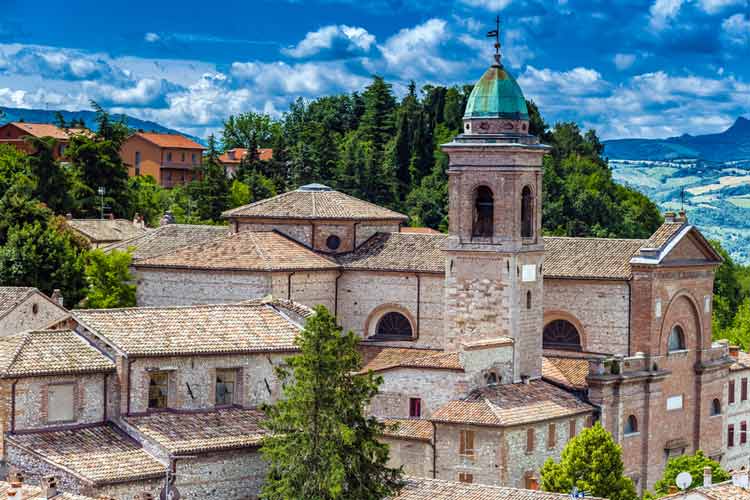Verucchio – Cradle of the Malatestas
From seat of the Villanovan civilisation to one of the most beautiful villages in Italy. The village of Verucchio (Vrócc in Romagna... Read More

Art, artefacts and signs of a history that began 3000 years ago. Malatesta Fortress 12th – 16th century. It is located on top of the rock that overlooks the town and provides a 360° view of the town itself, the hills, the Marecchia river valley and the plains as far as the Adriatic Coast.
The Rocca Malatestiana, also known as the Rocca del Sasso due to its location on the rocky spur above the village, is one of the largest Malatesta fortifications built between the 12th and 16th centuries AD and still well preserved.
The fortress was the birthplace of Malatesta da Verucchio, known as the “Centenary”, mentioned by Dante in the Divine Comedy as the “Mastin Vecchio”, founder of the dynasty and father of Giangiotto and Paolo, famous for their love and death story with Francesca da Rimini.
It can be visited in its entirety (0541-670222).
It frequently hosts shows, exhibitions, conferences and cultural events.
The second Malatesta fortress; the monastery of the Nuns of St Clare (1600) was built on top of this, and is now being redeveloped.
Along the “walls of San Giorgio” we enter Verucchio through the ancient gateway, faithfully and splendidly reconstructed.
This is one of the oldest buildings in Verucchio; it stands at the foot of the rock and can be reached by taking the road from the village down to the hamlet of Villa Verucchio.
Of Romanesque-Gothic architecture, its construction dates from around 990; the parish church is dedicated to St Martin.
Built in 1863 to a design by Antonio Tondini of Verucchio (the project was signed by Giovanni Morolli of Rimini because Tondini was unlicensed), this imposing and solemn church has Renaissance and Baroque motifs inside and contains two Crucifixes, masterpieces painted on panels: one by the Venetian Catarino (wooden structure) and Nicolò di Pietro and the other by an unknown 14th-century Rimini artist of the school of Giotto, known as the “Master of Verucchio”.
Among the various altarpieces in the Collegiate Church, of particular note is the one on the high altar (Giovan Francesco Nagli, known as Il Centino – mid-17th century), with St Martin giving his cloak to the poor man.
Located in the upper part of Verucchio. The convent, inhabited since the 16th century for several centuries, is now private property. One of the four Villanovan-Etruscan necropolises discovered in Verucchio was in this area.
Some sections of the walls built around the village and the Passerello Fortress are visible. They take their name from the former Capuchin convent of San Giorgio, built in the 16th century at the summit.
Overlooking Verucchio’s main square, Piazza Malatesta, this palace dates from the 17th-18th centuries. The façade features typical architectural elements of the period.
The Franciscan Convent of the Friars Minor (13th century)
Flanked by the church of Santa Croce, it is located near the Via Marecchiese, in the hamlet of Villa Verucchio, about 2 km from the old town and the Rocca Malatestiana.
It was founded by St Francis in 1231 on the ruins of an old hermitage that hosted the saint and brother Leo during their return from San Leo, where St Francis had received the Monte della Verna as a gift from messer Orlando de’ Cattani della Chiusi, who was enraptured by his encounter with the saint and his speeches.
Tradition has it that, among other miracles that St. Francis is said to have performed on the site, he planted his dry cypress tree, which came back to life. Today, after almost 800 years, an age also confirmed by botanists, its extraordinary dimensions (23 m high and 7.5 m in diameter) make it a true monument that is certainly worth a visit.
Healing waters gush out near the Convent, which, according to legend, were made to flow from the Saint when he passed by.
It collects prehistoric finds from the early Iron Age, belonging to the Villanovan civilisation. The first finds of this ancient prehistoric population were discovered in Villanova, near Bologna; the locality gave its name to the Villanovan culture, characterised by its own decorative style of pottery.
Verucchio has been and still is a protagonist in the study and knowledge of the Villanovan culture thanks to the archaeological excavations carried out in 1893, which discovered the Necropolis of Campo del Tesoro and Fondo Lavatoio (9th century B.C.), and in the 1960s and 70s, which brought to light tombs, weapons, tools, fibulae, necklaces, worked bones; objects – especially funeral ornaments – which give credence to the hypothesis that Verucchio was an Etruscan outpost towards the Adriatic Sea.
The Rimini-Verucchio Golf Club (18 championship holes and 7 executive holes) is located on the banks of the Marecchia River in the flat part of Villa Verucchio. All around there is an incomparable view of the villages of Verucchio, Torriana and San Leo.